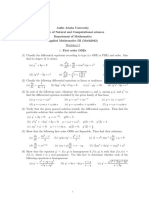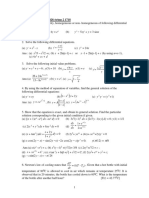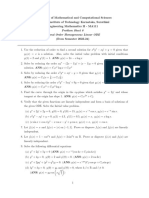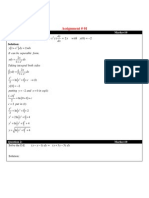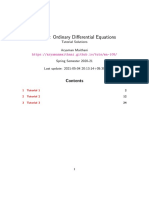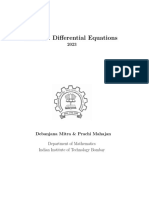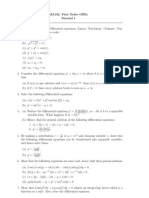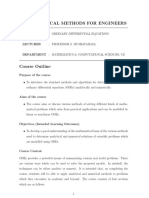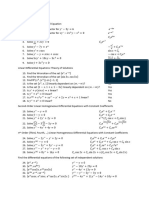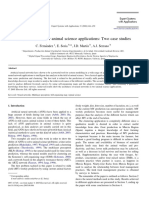COEP Technological University Pune
(A Public University of Government of Maharashtra, Pune-411005)
(MA-23008) Differential Equations and Complex Algebra
F.Y. B.Tech. Spring Semester 2024-25 (E and TC, Electrical, Instru )
Tutorial 1
Topic : Ordinary Differential Equations 1
Co-ordinator : Dr. Kiran Dalvi
—————————————————————————————————————
1. Explain the basic concepts of ordinary and partial differential
equations (ODEs, PDEs), order, general and particular solutions, initial
value problems (IVPs). Give one example of each.
2. What is a linear ODE ? Why is it easier to solve than a nonlinear ODE ?
3. Does every first-order ODE have a solution ? A solution formula ?
Give examples.
4. Can an ODE sometimes be solved by several methods ? Give three
examples.
5. Find an ODE for the straight lines through the origin.
(Ans : xdy − ydx = 0)
6. Verify that the given function is a solution of corresponding
differential equation. (a, b are arbitrary constants.)
(i) y = a cos πx + b sin πx, y 00 + π 2 y = 0
(ii) y = 5e−2x Z x
+ 2x2 + 2x + 1, y 0 + 2y = 4(x + 1)2
2 2
(iii) y = ex e−t dt, y 0 = 2xy + 1
0
(iv) y = − sin x + ax2 + bx + c, y 000 = cos x
(v) x2 + y 2 = 1, x + yy 0 = 0
1
�7. Obtain the general solution (or particular solution) of the following
differential equations.
(i) y (3) = e−0.2x
(ii) y 0 = 2 sec 2y
dr
(iii) = −2tr; r(0) = r0
dt
(iv) x0 = cos(x + y)√
(v) x dy − y dx = x x!2 + y 2 dx ; y(1) = 1
y y
(vi) y 0 = + x sin
x x
8. Solve the following linear/ nonlinear differential equations :
dy √
(i) x(1 − x2 ) + (2x2 − 1) y = x3 (Ans : y = x + cx 1 − x2 )
dx
(ii) e−y sec2 y dy = dx + x dy (Ans : x ey = tany + c)
dy
(iii) = x3 y 3 − xy
dx
9. Apply the given operator to the given function (show all the steps
in detail) :
x x x
(i) 8D2 + 2D − I; cosh , sinh , e 2
2 2
(ii) (D + 5I)(D − I); e−3x sin x, e3x , x2
(iii) (D − 4I)(D + 3I); x3 − x2 , sin 4x, e−3x
10. Check whether the following functions are linearly independent or
dependent on the given interval ?
1 x
!
2 −x
(i) x , 2 , 0 ; (x ≥ 0) (ii) e , cos , 0; (−1 ≤ x ≤ 1)
x 2
(iii) x2 , ln x2 ; (x > 1) (iv) cosh 2x, sinh 2x, e2x ; (x ≥ 0)
(v) x2 , x|x|; [−1, 1] (vi) x2 , x|x|; (0, ∞)
2
�11. Find linear ODE for which the following functions are linearly
independent solutions :
(i) 1, e−2x (ii) cos 5x, sin 5x (iii) x2 , x3 (iv) ex , xex (v) x, x ln x
(vi) 1, x, cos 2x, sin 2x (vii) ex , xex , cos x, sin x, x cos x, x sin x
(viii) e−(s+it)x , e−(s−it)x (ix) ex , e−x , e2x (x) e−kx cos πx, e−kx sin πx
12. What is the superposition or linearity principle ? For what nth -order
ODEs does it hold ?
13. Reduce to first order and solve, showing each step in detail :
(i) y 00 + (y 0 )3 sin y = 0
(ii) 2xy 00 = 3y 0
14. Find the curve through the origin in the xy− plane which satisfies
2x
y 00 = 2y 0 and whose tangent at the origin has slope 1. (Ans : − 12 + e2 )
♦♦♦♦♦♦♦♦♦
An equation for me has no meaning , unless it expresses a thought
of God. - Srinivasa Ramanujan

